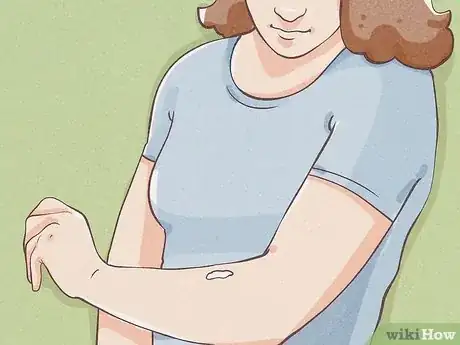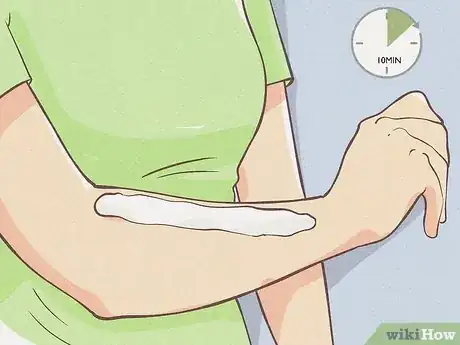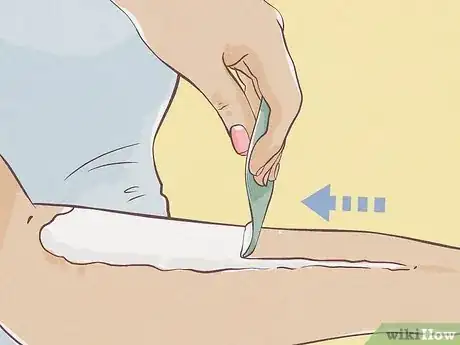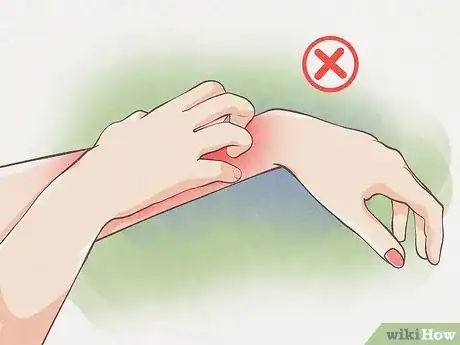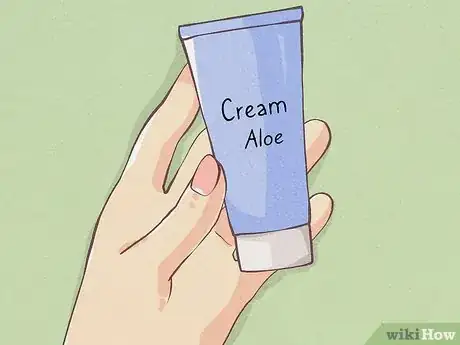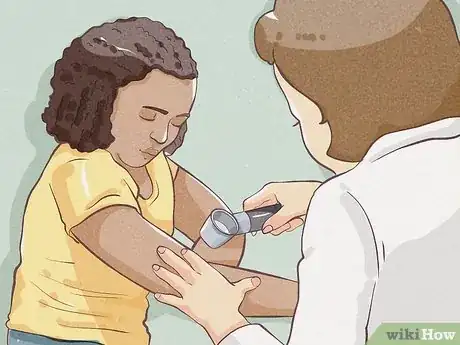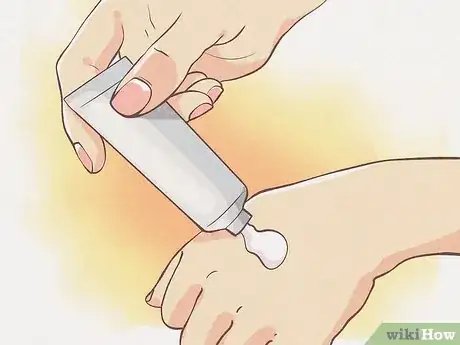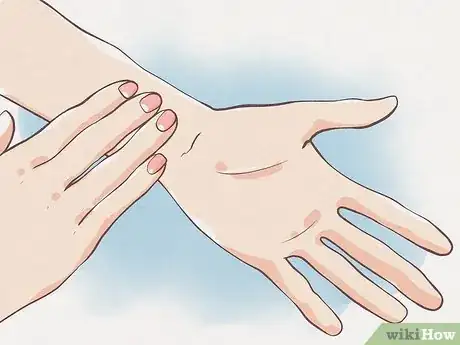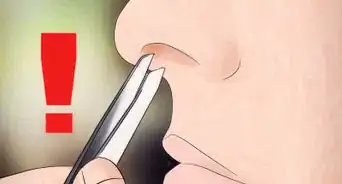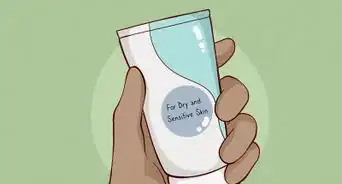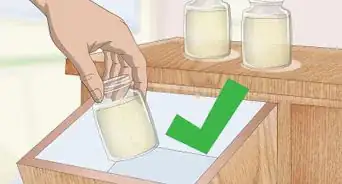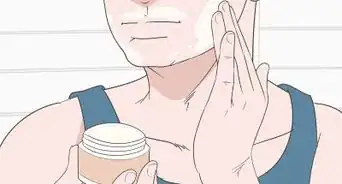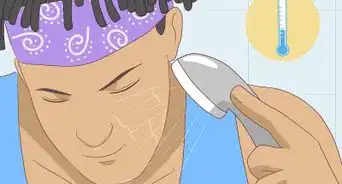This article was co-authored by Heather Richmond, MD. Dr. Heather Richmond, MD is a board certified Dermatologist at Dermatology and Laser Surgery Center in Houston, Texas. With over nine years of experience, Dr. Richmond specializes in comprehensive dermatology including medical, surgical, and cosmetic procedures. She graduated cum laude from Yale University with a BA in Molecular, Cellular, and Developmental Biology. She earned her MD from the University of California, Irvine School of Medicine, where she was inducted into the Alpha Omega Alpha Honor Medical Society. She completed her Internal Medicine internship at Cedars-Sinai Medical Center and her Dermatology residency at The University of Texas MD Anderson Cancer Center in Houston. Dr. Richmond is a fellow of the American Academy of Dermatology and is a member of the American Society for Dermatologic Surgery, American Society for Laser Medicine and Surgery, and the Texas and Houston Dermatological Societies.
There are 10 references cited in this article, which can be found at the bottom of the page.
This article has been viewed 615,355 times.
If you're tired of shaving all the time but you don't want to face the pain of waxing, a hair removal cream might be the perfect fit for your grooming needs. Also known as depilatory creams, they are quick, inexpensive, and easy to use. Read on to learn how to safely and effectively use a depilatory cream for smooth skin that can last up to a week.
Steps
Applying the Cream
-
1Read the directions that came with the cream and follow them exactly. Different brands and different products within that brand will have different instructions. One type of hair removal might take only three minutes, while another might take ten.[1] Following the directions will give you the best results and help protect your skin.[2]
- If you lost the directions that came with your cream, you can find them on the bottle or tube. Otherwise, check the company's website. They should have instructions for each kind of cream.
- Check the "use by" date to make sure your cream is not expired. An expired depilatory cream will not work very well and give you poor results.
-
2Apply a thick, even layer over the hair you want to remove. Use your fingers or a spatula, if provided. Do not rub the cream into your skin, just spread it.[3] Wash your hands immediately if you apply with your fingers.
- Uneven application means your hair could come off in patches, leaving you with spots of hair, which is probably not the look you're going for.[4]
- Never apply a hair removal cream to your nostrils, ears, the skin around your eyes (including your eyebrows), genitals, anus, or nipples.
Advertisement -
3Leave the cream on for the amount of time recommended in the directions. This can be anywhere between three to ten minutes, though the time rarely exceeds ten minutes. Most directions recommend checking a small area about halfway through the process to see if hair comes off.[5] The shorter the amount of time the depilatory cream is in contact with your skin, the less likely you are to develop redness or irritation.
- Because you can really harm your skin if you leave the cream on too long, set an egg timer or use the timer on your phone to make sure you don't exceed the limit.
- Some tingling is normal, but if you start to feel burning, see redness or irritation, remove the cream immediately. Depending on your reaction, you may want to call your doctor for advice on how to treat your skin.
- You may notice a bad smell while you are using the cream. That's a normal side effect of the chemical reaction that is breaking down your hair.[6]
-
4Remove the cream with a damp washcloth or spatula if provided. Wipe gently--don't rub the cream. Rinse the area with warm water to make sure the cream has been removed entirely.[7] If you don't rinse off the residue, the chemicals could continue to react with your skin and cause a rash or chemical burn.
-
5Don't worry if your skin is a little red or itchy after use--that's normal. Wear loose clothing right after using the cream and don't scratch the area. If the redness and discomfort continues after a few hours or gets worse, call your doctor.[10]
-
6Observe any warnings in the directions, such as avoiding sunbathing, swimming, and tanning for 24 hours. You should also wait 24 hours to use anti-perspirant or products with fragrances.[11]
- You should not shave or use a hair removal cream in the same area for 72 hours after use.
Things to Keep In Mind
-
1Find the right cream for your skin. There are lots of different brands of hair removal cream, and lots of choices within those brands. When choosing a cream, think about your skin's sensitivity and where you plan on using the product.[12] Some companies even make a waterproof depilatory that can be applied in the shower.
- If you are using the cream on your face or bikini area, make sure you choose formula specifically for those areas, as the skin is more sensitive.[13]
- If you have sensitive skin, look for creams with ingredients like aloe and green tea. You may also want to speak with a doctor or dermatologist before use.[14]
- Depilatory creams can come in different forms, from aerosols (or sprays), gels, and roll-ons.[15]
- A roll-on won't be as messy as a cream or gel, but the creams and gels let you control how thick you apply them (and usually the thicker the better).[16]
- If you are sensitive to smells, try a cream that has added a scent to cover the eggy smell of the cream reacting to your hair. Just remember that additional ingredients can increase the chances of irritation.[17]
- Buy from a reputable place instead of buying from a random site on the internet.[18]
- If the price of a product is too low compared to its retail price, it may not be genuine.[19]
-
2Talk to your doctor if you have very sensitive skin, a skin condition, or take any medications that may affect your skin. Because the cream is applied directly to the skin, the chemicals that break down the proteins in your hair will also interact with the proteins in your skin and could cause a reaction.[20] Consult your doctor before using depilatory creams if:
- You have developed rashes, hives, or allergic reactions to skin products in the past.
- You take a retinol, acne medication, or other medication that increases your skin's sensitivity.
- You have a skin condition such as eczema, psoriasis, or rosacea.
- Usually, dermatologists recommend using medical-grade creams with proven clinical benefits.[21]
-
3Do an allergy test 24 hours before using the cream, even if you've used it before. Your hormone levels are always changing, and they cause your skin to change, too. Even if you've never had a reaction to the hair removal cream before, your skin's chemistry may have changed slightly and could cause you to react.[22]
-
4Examine the area for any cuts, scrapes, moles, scars, cold sores, irritated or sunburnt skin. You want to minimize your chances of having a bad reaction to the cream and potentially developing a rash or chemical burn. Don't apply the cream directly to any scars or moles, and if you have a sunburn, rash or cut, wait until you are completely healed before going ahead with the application.[25]
- There may be tiny cuts on your skin if you have shaved recently--wait a day or two before applying the cream.[26]
-
5Take a shower or bath, drying your skin thoroughly afterwards. This will ensure you don't have any lotions or anything on your skin that might interfere with the hair removal cream. Make sure your skin is dry afterwards, as most depilatory creams need to be applied to dry skin.
Expert Q&A
-
QuestionAre there any creams to disguise scars from hair removal?
 Heather Richmond, MDDr. Heather Richmond, MD is a board certified Dermatologist at Dermatology and Laser Surgery Center in Houston, Texas. With over nine years of experience, Dr. Richmond specializes in comprehensive dermatology including medical, surgical, and cosmetic procedures. She graduated cum laude from Yale University with a BA in Molecular, Cellular, and Developmental Biology. She earned her MD from the University of California, Irvine School of Medicine, where she was inducted into the Alpha Omega Alpha Honor Medical Society. She completed her Internal Medicine internship at Cedars-Sinai Medical Center and her Dermatology residency at The University of Texas MD Anderson Cancer Center in Houston. Dr. Richmond is a fellow of the American Academy of Dermatology and is a member of the American Society for Dermatologic Surgery, American Society for Laser Medicine and Surgery, and the Texas and Houston Dermatological Societies.
Heather Richmond, MDDr. Heather Richmond, MD is a board certified Dermatologist at Dermatology and Laser Surgery Center in Houston, Texas. With over nine years of experience, Dr. Richmond specializes in comprehensive dermatology including medical, surgical, and cosmetic procedures. She graduated cum laude from Yale University with a BA in Molecular, Cellular, and Developmental Biology. She earned her MD from the University of California, Irvine School of Medicine, where she was inducted into the Alpha Omega Alpha Honor Medical Society. She completed her Internal Medicine internship at Cedars-Sinai Medical Center and her Dermatology residency at The University of Texas MD Anderson Cancer Center in Houston. Dr. Richmond is a fellow of the American Academy of Dermatology and is a member of the American Society for Dermatologic Surgery, American Society for Laser Medicine and Surgery, and the Texas and Houston Dermatological Societies.
Board Certified Dermatologist Absolutely! There are a variety of different bleaching creams you can use that will disguise the skin and keep it from standing out. There are products like hydroquinone, which requires a prescription, that do a great job at covering up the kind of blemishes you're describing.
Absolutely! There are a variety of different bleaching creams you can use that will disguise the skin and keep it from standing out. There are products like hydroquinone, which requires a prescription, that do a great job at covering up the kind of blemishes you're describing. -
QuestionWhat does retinol do?
 Heather Richmond, MDDr. Heather Richmond, MD is a board certified Dermatologist at Dermatology and Laser Surgery Center in Houston, Texas. With over nine years of experience, Dr. Richmond specializes in comprehensive dermatology including medical, surgical, and cosmetic procedures. She graduated cum laude from Yale University with a BA in Molecular, Cellular, and Developmental Biology. She earned her MD from the University of California, Irvine School of Medicine, where she was inducted into the Alpha Omega Alpha Honor Medical Society. She completed her Internal Medicine internship at Cedars-Sinai Medical Center and her Dermatology residency at The University of Texas MD Anderson Cancer Center in Houston. Dr. Richmond is a fellow of the American Academy of Dermatology and is a member of the American Society for Dermatologic Surgery, American Society for Laser Medicine and Surgery, and the Texas and Houston Dermatological Societies.
Heather Richmond, MDDr. Heather Richmond, MD is a board certified Dermatologist at Dermatology and Laser Surgery Center in Houston, Texas. With over nine years of experience, Dr. Richmond specializes in comprehensive dermatology including medical, surgical, and cosmetic procedures. She graduated cum laude from Yale University with a BA in Molecular, Cellular, and Developmental Biology. She earned her MD from the University of California, Irvine School of Medicine, where she was inducted into the Alpha Omega Alpha Honor Medical Society. She completed her Internal Medicine internship at Cedars-Sinai Medical Center and her Dermatology residency at The University of Texas MD Anderson Cancer Center in Houston. Dr. Richmond is a fellow of the American Academy of Dermatology and is a member of the American Society for Dermatologic Surgery, American Society for Laser Medicine and Surgery, and the Texas and Houston Dermatological Societies.
Board Certified Dermatologist Retinols are vitamin A derivative creams. They stimulate new collagen, help to thicken the skin and minimize wrinkles over time.
Retinols are vitamin A derivative creams. They stimulate new collagen, help to thicken the skin and minimize wrinkles over time. -
QuestionWhy is eczema and psoriasis similar?
 Heather Richmond, MDDr. Heather Richmond, MD is a board certified Dermatologist at Dermatology and Laser Surgery Center in Houston, Texas. With over nine years of experience, Dr. Richmond specializes in comprehensive dermatology including medical, surgical, and cosmetic procedures. She graduated cum laude from Yale University with a BA in Molecular, Cellular, and Developmental Biology. She earned her MD from the University of California, Irvine School of Medicine, where she was inducted into the Alpha Omega Alpha Honor Medical Society. She completed her Internal Medicine internship at Cedars-Sinai Medical Center and her Dermatology residency at The University of Texas MD Anderson Cancer Center in Houston. Dr. Richmond is a fellow of the American Academy of Dermatology and is a member of the American Society for Dermatologic Surgery, American Society for Laser Medicine and Surgery, and the Texas and Houston Dermatological Societies.
Heather Richmond, MDDr. Heather Richmond, MD is a board certified Dermatologist at Dermatology and Laser Surgery Center in Houston, Texas. With over nine years of experience, Dr. Richmond specializes in comprehensive dermatology including medical, surgical, and cosmetic procedures. She graduated cum laude from Yale University with a BA in Molecular, Cellular, and Developmental Biology. She earned her MD from the University of California, Irvine School of Medicine, where she was inducted into the Alpha Omega Alpha Honor Medical Society. She completed her Internal Medicine internship at Cedars-Sinai Medical Center and her Dermatology residency at The University of Texas MD Anderson Cancer Center in Houston. Dr. Richmond is a fellow of the American Academy of Dermatology and is a member of the American Society for Dermatologic Surgery, American Society for Laser Medicine and Surgery, and the Texas and Houston Dermatological Societies.
Board Certified Dermatologist Both eczema and psoriasis are rashes that can be extensive and potentially affect different parts of the entire body.
Both eczema and psoriasis are rashes that can be extensive and potentially affect different parts of the entire body.
References
- ↑ Heather Richmond, MD. Board Certified Dermatologist. Expert Interview. 24 September 2020.
- ↑ http://www.naircare.ca/media/files/products/instructions/Nair_Cream_for_Face__upper_lip_insert_English__.pdf
- ↑ http://www.naircare.ca/media/files/products/instructions/Nair_Cream_for_Face__upper_lip_insert_English__.pdf
- ↑ http://health.howstuffworks.com/skin-care/beauty/hair-removal/hair-removal-creams3.htm
- ↑ http://www.naircare.ca/media/files/products/instructions/Nair_Cream_for_Face__upper_lip_insert_English__.pdf
- ↑ http://health.howstuffworks.com/skin-care/beauty/hair-removal/5-facts-to-know-about-hair-removal-creams1.htm
- ↑ http://www.naircare.ca/media/files/products/instructions/Nair_Cream_for_Face__upper_lip_insert_English__.pdf
- ↑ http://www.naircare.ca/media/files/products/instructions/Nair_Cream_for_Face__upper_lip_insert_English__.pdf
- ↑ http://www.naircare.ca/media/files/products/instructions/Nair_Cream_for_Face__upper_lip_insert_English__.pdf
- ↑ http://health.howstuffworks.com/skin-care/beauty/hair-removal/5-facts-to-know-about-hair-removal-creams1.htm
- ↑ Heather Richmond, MD. Board Certified Dermatologist. Expert Interview. 24 September 2020.
- ↑ http://health.howstuffworks.com/skin-care/beauty/hair-removal/hair-removal-creams4.htm
- ↑ http://health.howstuffworks.com/skin-care/beauty/hair-removal/hair-removal-creams4.htm
- ↑ http://health.howstuffworks.com/skin-care/beauty/hair-removal/hair-removal-creams4.htm
- ↑ http://health.howstuffworks.com/skin-care/beauty/hair-removal/hair-removal-creams1.htm
- ↑ http://health.howstuffworks.com/skin-care/beauty/hair-removal/hair-removal-creams4.htm
- ↑ http://health.howstuffworks.com/skin-care/beauty/hair-removal/5-facts-to-know-about-hair-removal-creams1.htm
- ↑ Heather Richmond, MD. Board Certified Dermatologist. Expert Interview. 15 September 2020.
- ↑ Heather Richmond, MD. Board Certified Dermatologist. Expert Interview. 15 September 2020.
- ↑ Heather Richmond, MD. Board Certified Dermatologist. Expert Interview. 24 September 2020.
- ↑ Heather Richmond, MD. Board Certified Dermatologist. Expert Interview. 15 September 2020.
- ↑ http://www.naircare.com/en/Women/FAQ#sthash.u1opiTDI.dpuf
- ↑ http://www.naircare.ca/media/files/products/instructions/Nair_Cream_for_Face__upper_lip_insert_English__.pdf
- ↑ http://www.naircare.ca/media/files/products/instructions/Nair_Cream_for_Face__upper_lip_insert_English__.pdf
- ↑ http://health.howstuffworks.com/skin-care/beauty/hair-removal/5-facts-to-know-about-hair-removal-creams4.htm
- ↑ http://health.howstuffworks.com/skin-care/beauty/hair-removal/hair-removal-creams3.htm
- ↑ http://www.webmd.com/beauty/dry-skin-13/cosmetic-procedures-skin-care-dry-skin
- ↑ http://www.naircare.ca/media/files/products/instructions/Nair_Cream_for_Face__upper_lip_insert_English__.pdf
About This Article
Before you use a hair removal cream, apply a small amount of the cream to your skin and follow the directions on the label. Wait a day and look for unusual inflammation, itching, or redness, which could indicate an allergic reaction. If your skin looks and feels fine, get ready to use the cream by taking a shower to and drying off. Then, spread a thick layer of cream over the area and wait the amount of time specified in the directions. Once the time has passed, wipe off the cream and rinse off with warm water. To learn how to find the right hair removal cream for you, keep reading.


